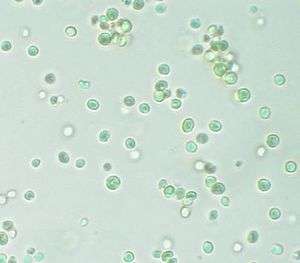Eustigmatophyte
| Eustigmatophytes | |
|---|---|
 | |
| Nannochloropsis sp. | |
| Scientific classification | |
| Domain: | Eukaryota |
| (unranked): | SAR |
| Subkingdom: | Halvaria |
| (unranked): | Stramenopiles |
| Division: | Ochrophyta |
| Subdivision: | Phaeista |
| Class: | Eustigmatophyceae Hibberd & Leedale, 1971 |
| Order | |
| |
Eustigmatophytes are a small group (12 genera; ~41 species) of eukaryotic algae that includes marine, freshwater and soil-living species.[1][2]
All eustigmatophytes are unicellular, with coccoid cells and polysaccharide cell walls. Eustigmatophytes contain one or more yellow-green chloroplasts, which contain chlorophyll a and the accessory pigments violaxanthin and β-carotene. Eustigmatophyte zoids (gametes) possess a single or pair of flagella, originating from the apex of the cell. Unlike other heterokontophytes, eustigmatophyte zoids do not have typical photoreceptive organelles (or eyespots); instead an orange-red eyespot outside a chloroplast is located at the anterior end of the zoid.
Ecologically, eustigmatophytes occur as photosynthetic autotrophs across a range of systems. Most eustigmatophyte genera live in freshwater or in soil, although Nannochloropsis contains marine species of picophytoplankton (2 → 4 μm).
The class was erected to include some algae previously classified in the Xanthophyceae.[3]
Classification
- Class Eustigmatophyceae Hibberd & Leedale 1970
- Order Eustigmatales Hibberd 1981
- Family Loboceae Hegewald 2007[4]
- Genus Pseudotetraëdriella Hegewald & Padisák 2007
- Family Chlorobothryaceae Pascher 1925
- Genus Chlorobotrys Bohlin 1901
- Family Monodopsidaceae Hibberd 1981
- Genus Microchloropsis Fawley, Jameson & Fawley 2015
- Genus Monodopsis Hibberd 1981
- Genus Nannochloropsis Hibberd 1981
- Family Pseudocharaciopsidaceae Lee & Bold ex Hibberd 1981
- Genus Botryochloropsis Preisig & Wilhelm 1989
- Genus Pseudocharaciopsis Lee & Bold 1973
- Genus Ellipsoidion Pascher 1937
- Family Eustigmataceae Hibberd 1981
- Genus Pseudellipsoidion Neustupa & Nemková 2001
- Genus Pseudostaurastrum Chodat 1921
- Genus Eustigmatos Hibberd 1981
- Genus Vischeria Pascher 1938
- Family Loboceae Hegewald 2007[4]
- Order Eustigmatales Hibberd 1981
References
- ↑ Hoek, C. van den, Mann, D. G. and Jahns, H. M. (1995). Algae : An introduction to phycology, Cambridge University Press, UK.
- ↑ Guiry, M.D. & Guiry, G.M. (2016). "Eustigmatales". AlgaeBase. National University of Ireland, Galway.
- ↑ Hoek, C. van den et al., p. 131.
- ↑ Hegewald E., Padisák J., Friedl T. 2007. Pseudotetraëdriella kamillae: taxonomy and ecology of a new member of the algal class Eustigmatophyceae (Stramenopiles). Hydrobiologia 586 (1): 107—116.

